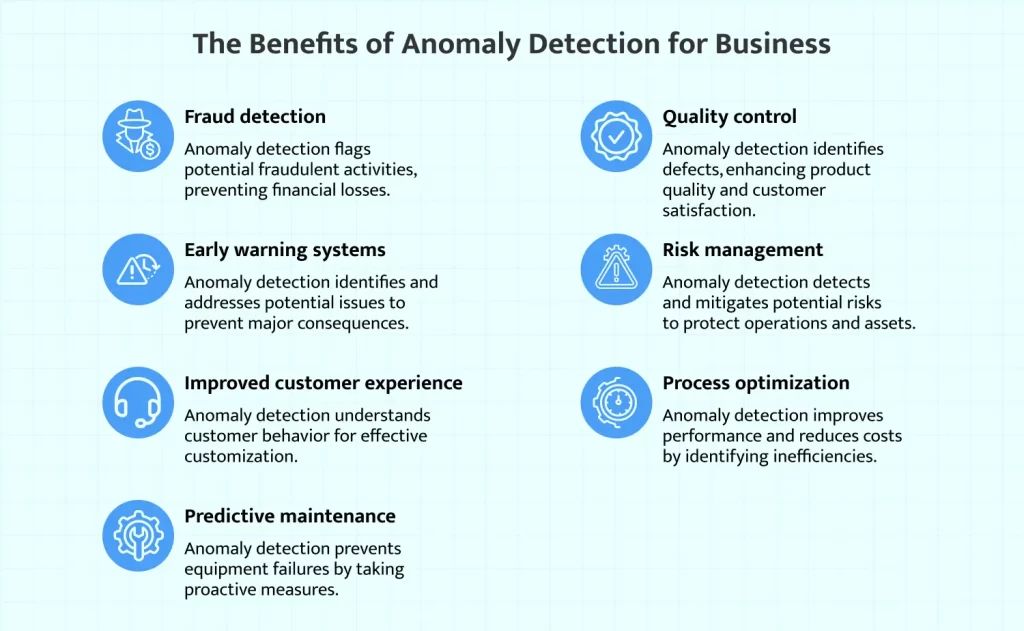Everything you need to know about anomaly detection in ML

As businesses continue to collect vast amounts of data, detecting anomalies or outliers in machine learning can be critical to identifying potential problems or opportunities. This is where anomaly detection in machine learning comes into play.
At Alternative-spaces, our expertise in this field enables us to develop effective anomaly detection strategies that help businesses gain valuable insights and take proactive measures to prevent negative consequences. In this article, we will explore the fundamentals of anomaly detection, the techniques for identifying anomalies in data, and the benefits it can bring to businesses.
Table of contents
- How Anomaly Detection Works
- Techniques for Identifying Anomalies in Data
- The Role of ML in Anomaly Detection
- The Benefits of Anomaly Detection for Business
- Challenges and Limitations of Anomaly Detection
- Let’s summarize
- FAQ
How Anomaly Detection Works
Machine learning for anomaly detection works by identifying unusual or unexpected patterns in data that may indicate a problem or opportunity. Anomaly detection aims to flag data points that deviate significantly from the norm and require further investigation or action. Here are a few examples of how anomaly detection works in different contexts:
Credit Card Fraud Detection
One application of anomaly detection is credit card fraud detection. Anomaly detection models are trained on normal spending behavior for each customer, such as average transaction amounts and the frequency of transactions. Any transactions deviating significantly from this expected behavior are flagged as potential fraud. For example, if a customer typically spends $50-100 per transaction but suddenly makes a purchase for $10,000, this transaction would be flagged as a potential anomaly.
Network Intrusion Detection
Machine learning-based anomaly detection can also identify potential network security threats. For example, an anomaly detection algorithm could be trained to recognize normal network traffic patterns, such as the number of packets sent and received per second. Any sudden spikes or drops in these metrics could indicate a network intrusion or a denial-of-service (DoS) attack.
Predictive Maintenance
Anomaly detection can help predict when equipment or machinery will likely fail. By analyzing historical data from production processes, anomaly detection algorithms can identify patterns that may indicate impending equipment failures, such as increased vibration, temperature fluctuations, or abnormal noise levels. Predictive maintenance strategies can then be implemented to minimize downtime and reduce maintenance costs.
Healthcare
Anomaly detection can be used to identify patients requiring immediate medical attention. For example, an anomaly detection model could be trained on typical patient vital signs, such as blood pressure, heart rate, and oxygen levels. Any deviations from these normal ranges could indicate a potential medical emergency that requires immediate attention.
Overall, anomaly detection works by using machine learning algorithms to identify patterns in data that deviate significantly from the expected norm. By flagging potential anomalies, businesses can take proactive measures to prevent negative consequences and capitalize on opportunities for improvement.
Techniques for Identifying Anomalies in Data

There are several techniques used to identify anomalies in data in machine learning, including:
- Threshold-based methods: Threshold-based methods involve setting a threshold above or below which data points are considered an anomaly. Any data point that falls outside of this threshold is considered an anomaly. This approach is simple and easy to implement but may result in false positives if the threshold is set too low or false negatives if the threshold is set too high.
- Probabilistic methods: Probabilistic methods use probability theory to identify anomalies outside expected distributions. One example of this approach is the Gaussian distribution, which assumes a normal distribution of data points within a dataset. Any data points outside this distribution can be identified as potential anomalies.
- Distance-based methods: Distance-based methods involve measuring the distance between data points and identifying those farthest from the rest of the data. One example of this approach is the k-nearest neighbor (k-NN) algorithm, which identifies anomalies based on their distance from the k-nearest neighbors in the dataset.
- Clustering-based methods: Clustering-based methods group similar data points together and identify any points outside those clusters as anomalies. One example of this approach is the DBSCAN algorithm, which groups data points based on their density and identifies any points outside the dense areas as outliers.
- Deep learning methods: Deep learning methods involve using neural networks to learn patterns in data and identify anomalies. One example of this approach is the autoencoder algorithm, which uses a neural network to compress data into a lower-dimensional space and reconstruct it. Any data points not reconstructed accurately can be identified as potential anomalies.
Overall, each technique has its strengths and weaknesses, and the choice of method will depend on the specific use case and the nature of the data being analyzed. By applying these techniques, anomaly detection algorithms can effectively identify abnormal patterns in data and flag them for further investigation or action.
The Role of ML in Anomaly Detection
Machine learning (ML) plays a crucial role in anomaly detection by enabling algorithms to learn from large datasets and automatically adjust to new and changing data over time. By applying ML algorithms to large datasets, businesses can quickly identify potential anomalies and take action to prevent negative consequences.
Here are a few examples of how ML is used in anomaly detection:
Cybersecurity
ML algorithms can be trained on large volumes of network traffic data to detect anomalies that might indicate potential threats or attacks. Such data includes logs, alerts, and network flow data. By analyzing this data, ML models can learn patterns of normal or benign traffic and detect deviations from these patterns that could indicate an attack.

Healthcare
ML algorithms can be used to monitor patient vitals and detect potential anomalies, such as sudden changes in blood pressure or heart rate, which could indicate a medical emergency. Such models can alert healthcare providers to take immediate action to prevent further complications.
Industrial maintenance
ML algorithms can predict equipment failures by analyzing sensor data on key performance indicators (KPIs) such as vibration and temperature. Changes to these KPIs can signal possible equipment failure, and ML algorithms can detect such signals and alert operators for maintenance.
Anomaly detection in mechanical engineering can be used to identify defects and potential failures in equipment. Defectology involves analyzing data from sensors, such as vibration or temperature sensors, to detect anomalies that may indicate a defect or malfunction.
To detect anomalies, machine learning algorithms can be trained on historical data to learn normal behavior patterns. These algorithms use statistical techniques to calculate the probability of an observation being abnormal or different from the expected pattern.
For example, in the case of vibration sensors, the machine learning algorithm would learn the normal range of vibration readings for a particular machine. If the vibration reading falls outside the normal range, the algorithm will flag it as an anomaly.
Financial fraud detection
ML algorithms can be used to detect fraudulent credit card activity by analyzing historical transaction data. Anomaly detection is used to flag unusual transaction patterns that deviate from the norm, making it possible to identify fraudulent activity and take corrective action.
Overall, the role of ML in anomaly detection is essential to help businesses identify potential issues or opportunities in their operations and mitigate risks. By leveraging the power of ML algorithms, businesses can gain valuable insights into their operations and take proactive measures to prevent negative consequences.
The Benefits of Anomaly Detection for Business

There are many benefits that anomaly detection can bring to businesses, including:
Fraud detection
Anomaly detection can detect unusual patterns in transactions and flag potential fraudulent activities, helping businesses prevent financial losses due to fraud.
Early warning systems
Anomaly detection can identify potential problems before they become major issues, allowing businesses to take action before it is too late. This can help prevent system failures, downtime, and other negative consequences.
Improved customer experience
Anomaly detection can help businesses better understand customer behavior, preferences, and needs. By identifying patterns in customer behavior, businesses can tailor their products and services to meet the needs of their customers more effectively.
Predictive maintenance
Anomaly detection can be used to identify potential equipment failures before they occur. By monitoring equipment data, businesses can detect anomalies that may indicate impending failures and take corrective actions, reducing downtime and maintenance costs.
Quality control
Anomaly detection can help businesses identify defects and quality issues in products. By analyzing data from production processes, businesses can detect and correct anomalies that may indicate quality issues, improving product quality and customer satisfaction.
Risk management
Anomaly detection can help businesses identify potential risks, such as market fluctuations, supply chain disruptions, or cybersecurity threats. By detecting anomalies in relevant data, companies can take action to mitigate potential risks and protect their operations and assets.
Process optimization
Anomaly detection can help businesses optimize processes by identifying areas where improvements can be made. By monitoring data from operational processes, organizations can detect anomalies that may indicate inefficiencies and take corrective actions to improve performance and reduce costs.
In conclusion, anomaly detection is a powerful tool for businesses looking to stay ahead of the curve in an increasingly data-driven world. By leveraging the power of machine learning algorithms, businesses can quickly and accurately identify potential anomalies and take action to prevent negative consequences.
Read also: Top 10 Java Machine Learning Tools and Libraries
Challenges and Limitations of Anomaly Detection

While anomaly detection can be a powerful tool for identifying unusual patterns in data, some several challenges and limitations must be addressed:
- Data quality: Anomaly detection algorithms depend on the quality of the data being analyzed. If the data is incomplete or contains errors, it can result in false positives or negatives.
- Modeling complexity: Creating accurate models of normal behavior can be challenging, particularly in complex systems where normal behavior may be difficult to define.
- Computational resources: Some anomaly detection algorithms can be computationally intensive, requiring significant processing power and storage resources.
- Imbalanced datasets: In some cases, anomalies may be rare events, making it challenging to train algorithms on imbalanced datasets.
- Dynamic environments: Anomaly detection algorithms must be able to adapt to changing conditions, such as seasonal fluctuations or sudden changes in customer behavior.
- Interpretability: Some anomaly detection techniques, such as deep learning, can be difficult to interpret, making it challenging to understand why a particular data point was flagged as an anomaly.
- Human oversight: While machine learning algorithms can identify potential anomalies, human oversight is still necessary to confirm whether the identified patterns are actually anomalous and to take appropriate action.
In conclusion, while anomaly detection can be a powerful tool for identifying unusual patterns in data, it is crucial to understand the challenges and limitations of this technique. By addressing these challenges, businesses can develop more effective anomaly detection strategies and use them to gain valuable insights into their operations.
Let’s summarize
Anomaly detection in ML is a powerful tool for identifying potential problems or opportunities in large datasets. By leveraging different techniques and algorithms, businesses can gain valuable insights into their operations and take proactive measures to prevent negative consequences.
At Alternative-spaces, we specialize in developing customized anomaly detection strategies that help businesses identify potential issues or opportunities and take corrective action. Our team of experts can consult with you to create an effective anomaly detection strategy for your organization and help you leverage the power of machine learning to gain valuable insights into your operations.
If you want to learn more about how Alternative-spaces can help you with anomaly detection or any other machine learning-related issue, please contact our team today. We are always here to help you maximize your data and stay ahead of the competition.
FAQ
1. Q: What kind of data can anomaly detection be applied to? A: Anomaly detection can be applied to any type of data that has a normal or expected pattern. This includes cybersecurity data, healthcare data, financial data, and industrial data.
2. Q: How accurate are anomaly detection algorithms? A: The accuracy of anomaly detection algorithms depends on several factors, including the size and quality of the dataset, the choice of algorithm and parameters, and the level of variability or noise in the data. However, when properly trained and tested, anomaly detection algorithms can achieve high levels of accuracy.
3. Q: What are the benefits of using ML for anomaly detection? A: ML algorithms can quickly analyze large volumes of data and detect anomalies that might take humans much longer to find. By identifying potential issues or opportunities early on, businesses can take proactive measures to prevent negative consequences and capitalize on opportunities for improvement. Additionally, ML algorithms can adapt to new and changing data over time, making them ideal for anomaly detection in dynamic environments.
Content created by our partner, Onix-systems.
Source: https://onix-systems.com/blog/anomaly-detection-in-machine-learning Home
Home